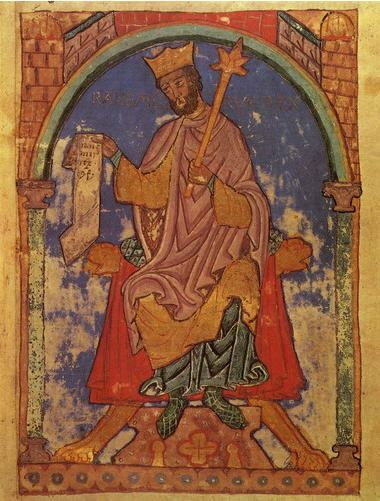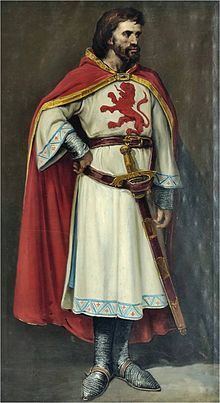Reign 931–951 Predecessor Alfonso IV | Successor Ordono III Name Ramiro of | |
 | ||
Died 1 January 951 (aged 50–51)Leon Burial Basilica of San Isidoro Consort Adosinda GutierrezUrraca of Pamplona | ||
Ramiro II (c. 900 – 1 January 951), son of Ordoño II, was a King of León from 931 until his death. Initially titular king only of a lesser part of the kingdom, he gained the crown of León (and with it, Galicia) after supplanting his brother Alfonso IV and cousin Alfonso Fróilaz in 931. The scant Anales castellanos primeros are a primary source for his reign.
Contents
Succession
When, shortly before his death in 910, Alfonso III of Asturias was forced by his sons to abdicate, the Kingdom of Asturias descended into a period of successional crises among the royal family and their supporters from the regional marcher aristocracies. The kingdom was initially partitioned, with García I receiving the León, Ordoño II Galicia and Fruela II the Asturian heartland.

With the successive deaths of García I (914) and Ordoño (924), these were re-consolidated, Fruela ruling the entirety of what would thenceforth be referred to as the Kingdom of León. His death the next year, 925, again brought about disputed succession and partition. A younger brother, Ramiro, appears to have married Fruela's widow and adopted the royal title, but gained no traction. Instead it was the next generation that rose to the forefront.
As eldest son of the prior king, Alfonso Fróilaz was crowned but proved unable to extend his power to the entire kingdom and was marginalized by his cousins the three sons of Ordoño II, who had the backing of the Kingdom of Pamplona. These brothers again partitioned the portion of the kingdom they controlled: the eldest, Sancho Ordóñez, ruling in Galicia, Alfonso IV in León, and Ramiro II in the newly conquered lands to the south (al-Andalus chronicler Ibn Hayyan located his court at Coimbra).
When Sancho died in 929 his kingdom was absorbed by Alfonso IV, but in a quick succession of events taking place in Leon and Zamora, Ramiro forced the abdication of Alfonso IV, and had him and Fruela II's three sons blinded in order to make them incapable of ruling.
Reign
Ramiro stood out as an excellent military commander, and expanded remarkably his territories south (Salamanca, Ledesma,...) as well as founding or repopulating frontier strongholds (Osma, Clunia,...). Ramiro masterminded a Pamplona/León coalition that defeated a joint Andalusian counter-offensive in the Battle of Simancas (939). This victory allowed the advance of the Leonese border of the Duero to the Tormes.
In the last years of his reign, he lost the support of his Pamplona brother-in-law/son-in-law García Sánchez I, who then helped another brother-in-law, the count Fernán González of Castile, to gain brief de facto independence. Still in 950 Ramiro launched an expedition to the valley of the Edge and defeated the Cordovan Umayyads at Talavera.
Family
Ramiro II married twice, first to his first cousin Adosinda Gutiérrez, daughter of Gutier Osóriz and Ildonzia Menéndez (a sister of Ramiro's mother, queen Elvira Menéndez), and second to Urraca Sánchez of Pamplona, daughter of Sancho I of Pamplona and Toda. By Adosinda, who was also cousin of San Rosendo, Ramiro had Bermudo and Ordoño III, and presumably also daughter Theresa, wife of García Sánchez I of Pamplona. García is referred to as Ramiro's son-in-law by chronicler Ibn Hayyan, and his eldest son by his documented second wife Theresa was named Ramiro, while Theresa would not have been daughter of Ramiro II's second wife, who was her husband's sister. By Urraca, Ramiro had two children, Sancho I of León and Elvira Ramírez.
He figures prominently in the romantic poem, the Miragaia, which tells the apocryphal story of Ramiro bedding Ortega, the daughter of a local Arab lord. By her he is given a son Alboazar, the progenitor of the Galician/Portuguese Maia family. This Maia tradition was subsequently linked to another legend, that told in the Cantar de los Siete Infantes de Lara by giving Ramiro and Ortega a daughter Ortega Ramírez, who is made to marry Gustios Gonzalez, grandfather of the legendary infantes and of hero Mudarra González. Subsequent elaboration of this legend gave further supposed descendants among the Lara family, but these Lara connections are dismissed by modern scholars.
